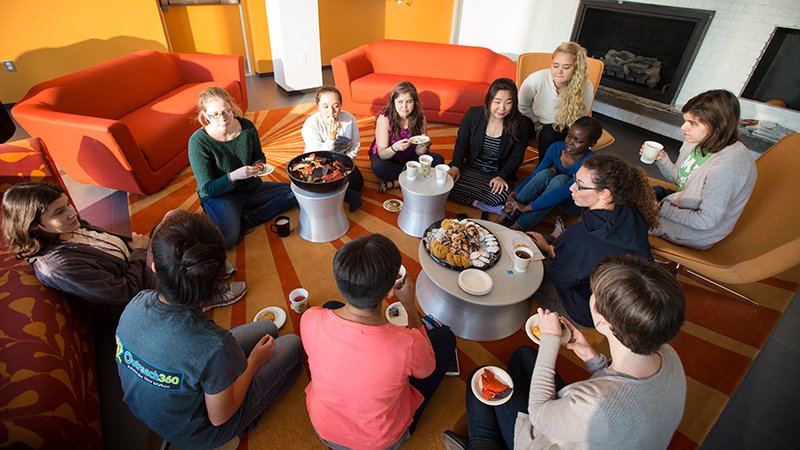Updated on March 10, 2025
This article was written by our Director of College Advising, Lauren Lynch.
Growing up in California, it was still a bit of a novelty (and an indulgence) to visit colleges on the East Coast prior to submitting an application. Like most of my friends, I applied sight unseen, then visited the colleges to which I had been admitted. To be clear, I don’t recommend this, as a student’s personal connection with a college is a far better determinant of their potential happiness and success than artificially manipulated rankings or presumed prestige.
For me, seeing schools only after admission provided some instant clarity: walking onto the campus of Smith College, I had a visceral, overwhelming sense of rightness, of being home.
The campus is beautiful — the requisite old buildings, an exquisite library, amazing houses (dorms), a world famous greenhouse, and Paradise Pond as the backdrop to crisp fall days and lazy spring mornings. But the most compelling aspect of Smith is its student body: women who are eager to engage, challenge, grow, support, laugh, and learn.
My time at Smith was shaped by the people around me, and has made me a proud and unwavering advocate for women’s colleges. As a psychology major and English minor, I took a wealth of classes covering multiple disciplines. Classroom discussions were lively, involved, often far-ranging, and always respectful.
Smith is part of the Five College Consortium, consisting also of Amherst College, University of Massachusetts Amherst, Mount Holyoke College (another women’s college) and Hampshire College, so there were often students from other schools — men and women — in our classes.
The Five College Consortium gives students a chance to “get out of the Smith bubble”
The diversity of perspective was appreciated, yet the predominant theme was one of barely reigned in intellectual energy. We were encouraged to challenge established thinking, seek new answers to age old questions, and take up space — intellectually and personally — on the academic landscape. We talked constantly, with each other, with our professors, and I remain convinced that my time at Smith taught me to be an excellent self-advocate, a talented public speaker, unafraid to have original or unpopular opinions, a voracious reader, and wholly devoted to helping women around me find their place in the world.
So what are some of the reasons to attend a women’s college?
Women graduate in four years at a higher rate from women’s colleges than they do from co-ed institutions.
They are also more likely to be employed in their chosen field within a year of graduation, more likely to work in STEM (science, technology, engineering, and mathematics), and more likely to hold executive or senior-level management positions within 10 years of graduation, according to studies by the Women’s College Coalition and American Association of University Women.
Why? At women’s colleges, women receive the support and resources they need to excel. Science labs, art studios, dedicated faculty, financial and personal support, and an endlessly uplifting alumnae network all serve one unique purpose: creating individual excellence and a legacy of extraordinary achievements by women, and for women.
A women’s college is where students can find and exercise their unique identities and voices, and proceed with confidence on their unique paths.
The diversity on women’s college campuses is astounding.
With close to 25% international student enrollment at some women’s colleges, students benefit from the myriad perspectives and experiences of their peers. Nothing is off limits to women, so diverse intellectual pursuits and engagement are robust and encouraged.
In 2022, the percentage of self-identified white students at my alma mater Smith College was slightly under 50%, and nearly 18% were first generation college students. While many colleges try to bridge racial and socio-economic divides, women’s colleges are uniquely positioned to address racial, gender, and class barriers to education. By committing to equal access to stellar education, women’s colleges create a self-perpetuating endowment of financial resources and institutional impact.
My classmates did, and do, amazing things. Educators, doctors, global business leaders, politicians, artists, academics, entrepreneurs, scientists — all making an impact on local, national, and global stages.
The benefits of attending a women’s college continue long past your graduation.
Women in leadership positions become uniquely poised to raise up those who come behind them. As an active member of several alumnae groups, I am astounded by the integrity and generosity of my peers.
At a women’s college, supporting others is not a diminishing resource, and is, in fact, the backbone of the educational experience. While students challenge each other to excel, they do so in a mindful way, aware that their successes are enhanced by collective achievement.
The energy this generates is truly amazing. Being in a classroom with other genuinely invested learners, all eager to participate but not to dominate, is a hallmark of women’s colleges. Equally unique are the faculty who embrace the opportunity to devote endless time and energy towards the intellectual growth of their students.
When I recently returned to campus for a landmark reunion, I was overcome with nostalgia, pride and awe. It’s the rare individual who makes the most of every moment in college: I wish I could go back and immerse myself in art history, literature, or history, enjoying Friday Teas or sitting on the quad with my friends.
Smith’s tradition of sharing Friday afternoon tea together dates back over 100 years.
Reflecting back on my education and my personal experience, I felt immense gratitude to the faculty who nurtured my nervous, painfully young, and self-conscious self. I felt compelled to email my first year English professor — later my minor advisor — to thank him for the impact he had on my life. I did not expect him to remember me all those years later, but the email I received back from him was personal, full of warmth, and appreciative of the opportunity he had (and has) to teach at such a marvelous place.
“As a graduate of a women’s college, you are never alone.”
I may not have made a big mark on Smith, but it certainly left a big mark on me. The women I met, the opportunities and endless open doors I encountered, and the support I received during and after my time there have shaped my life in remarkable ways.
As a graduate of a women’s college, you are never alone, and instead have the collective power, fortitude, and insight of generations of change-makers carrying you in their wake. Being an alumna of a women’s college creates the indescribable sensation of living your life through the lens of the thousands of extraordinary, uniquely beautiful, powerful and inspirational women who have come before, and will follow after.
Update (March 13, 2023): Congratulations to Smith Women's Basketball on their historic advancement to the NCAA Division III Final Four!
Find your home at a women’s college:
Extremely selective (<30%)
Barnard College – New York, New York
Smith College – Northampton, Massachusetts
Wellesley College – Wellesley, Massachusetts
Highly selective (30-50%)
Bennett College – Greensboro, North Carolina
Bryn Mawr College – Bryn Mawr, Pennsylvania
Mount Holyoke College – South Hadley, Massachusetts
Notre Dame of Maryland University – Baltimore, Maryland
Scripps College – Claremont, California
Spelman College – Atlanta, Georgia
Moderately selective (50-70%)
Agnes Scott College – Decatur, Georgia
Bay Path University – Longmeadow, Massachusetts
Cedar Crest College – Allentown, Pennsylvania
College of Saint Mary – Omaha, Nebraska
Meredith College – Raleigh, North Carolina
Moore College of Art and Design – Philadelphia, Pennsylvania
Mount Mary University – Milwaukee, Wisconsin
Stephens College – Columbia, Missouri
Wesleyan College – Macon, Georgia
Less selective (>70%)
Alverno College – Milwaukee, Wisconsin
Brenau University – Gainesville, Georgia
College of Saint Benedict – St. Joseph, Minnesota
Columbia College – Columbia, South Carolina
Converse University – Spartanburg, South Carolina
Cottey College – Nevada, Missouri
Hollins University – Roanoke, Virginia
Mills College – Oakland, California (part of Northeastern University’s Oakland campus)
Saint Mary’s College – Notre Dame, Indiana
Saint Mary’s College – Moraga, California
Salem College – Winston-Salem, North Carolina
St. Catherine University – St. Paul, Minnesota
Simmons University – Boston, Massachusetts
Sweet Briar College – Sweet Briar, Virginia
Trinity Washington University – Washington, DC



